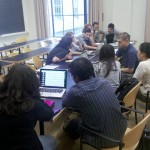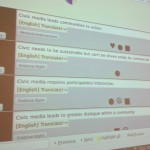Today was the second meeting of Intro to Civic Media, and it’s already clear that the semester is going to be an exciting one. After a spirited discussion of the issues raised by the students’ first round of blog entries, we experimented with May First / People Link’s Collaborative Democracy Workshop. This is a web based tool designed to help facilitate small group deliberation around a shared “Bill of Rights,” or in our case, Principles of Civic Media. The following images from our workshop show the process:
The full set of shared principles we developed are available at http://civicmedia.meetings.mayfirst.org. You can see by the number of little icons beneath each Principle how many of the small groups endorsed it. The most-endorsed were:
- Civic Media fosters greater dialogue and participation within a community
- Civic Media reflects the communities it serves
- Although Civic Media can take place on any media platform, it is about people and communities, not just about tools
- Civic Media needs to be sustainable but shouldn’t be driven solely by commercial intentions
- Communities can use Civic Media for action
- Civic Media connects us to other people by bridging communities of interest and communities of geography, and
- Civic Media is a pretense if people are denied access or unable to participate by design
What process did we use to arrive at these statements? May First / People Link describe the workshop as follows:
In each room, we break the participants into small groups of 4 – 5 people. Each small group speaks with one voice via a “scribe” who enters the group’s proposed rights into a web-based system. A dynamic, projected display of the current state of the aggregate Bill of Rights is visible to all.
All ideas belong to the entire workshop: any group can edit any Right, whether they wrote the original version or not All revisions of a given Right are stored, but only the most recent version is projected to the group as a whole. The group which creates a new version of a right automatically endorses that right, but otherwise holds no special connection to it.
Each group also has the ability to endorse any Right that seems worthy. When a Right is edited, existing endorsements are cleared; each group needs to decide if they want to endorse the new version. Rights with more endorsers float to the top of the projected list, while the rights with fewer endorsers sink to the bottom.
More info on the workshop is here, and you can check out the code from https://svn.mayfirst.org/mfpl/trunk/ir
All told, a very nice beginning to what promises to be a fruitful semester.



